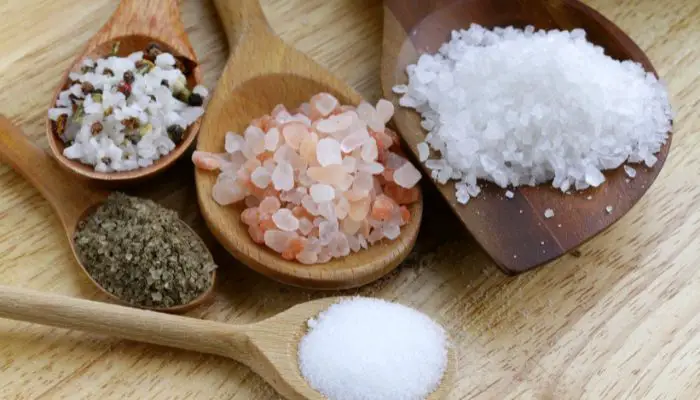You will understand the versatility of coffee if you are a coffee-aholic or if you are constantly in close proximity of coffee lovers.
One of the latest trends with coffee drinkers is adding a salt in coffee. This might be considered outrageous by coffee-lovers, but adding a pinch of salt to coffee can actually enhance its flavors and cut back on the bitterness and acidity.

If you are not much of a coffee enthusiast, standing in front of a coffee bar and ordering one for yourself might be quite intimidating. Coffee comes in a lot of variants.
Right from the place of origin to the container it is served in, with all the options of flavoring and additives to choose from, in between, coffee has all the capabilities of becoming everyone’s favorite thing.
On the other hand, if you find coffee your daily savior, you will be aware of the varieties it comes in. Black, with sugar, without sugar, with creamer, without creamer, decaf and the list goes on.
Let us explore and know more about adding a pinch of salt to coffee and what effect it has.
The best way to add salt to your coffee
According to the famous cookbook writer and TV personality Alton Brown, adding a quarter teaspoon of salt (which is just like a generous pinch of salt) to 6 tablespoons of coffee grounds balances off the bitterness and acidity levels in the coffee and enhances its inherent sweetness.
Then you can start your brew the way you normally would.
Salt also helps in diminishing the stale tank-water taste that many may find dominant in their cup of freshly brewed coffee. The salted coffee grounds can then be used to make coffee in any way as suited.
Another way of adding salt to your coffee is adding a pinch to the cup of your fresh coffee. Swirl it and dissolve with a spoon, sprinkle at the top of your coffee with your fingers or better yet, coat the rim of your coffee mug just like you do with your glass of margarita. Just make sure not to overdo it.
Health benefits of coffee and adding salt in it
Coffee is known for the myriad of health benefits it holds. It is jam-packed with antioxidants and a number of other beneficial nutrients like Potassium, Magnesium, and Manganese. Coffee alleviates your risk of diseases like Parkinson’s, Alzheimer’s and Dementia.
Coffee also helps in boosting your energy levels and burning fat. It is therefore recommended to have your cup of coffee free from fattening additives like sugar, milk, and creamer.
An alarming fact about consuming caffeine is that it makes you lose sodium and chloride (salt) from your body through urine. If you consume caffeine equivalent to six to seven cups of coffee per day, studies show that you might be at the risk of losing around 1840 mg of sodium each day through urine.
This amount of sodium is equal to a little over three-quarters of a teaspoon of salt. More alarming is the fact that caffeine increases the amount of sweat as well which means double loss of salt from the body.
It is therefore very beneficial if you add a pinch of salt to your cup of coffee. For a fancier experience why not try salted caramel coffee? The idea behind adding salt to coffee is to make up for the loss of salt from the body because of caffeine.
Some low-quality coffee beans or a light to medium roast may induce acidity which may result in acid reflux. The best solution is to switch your coffee brand and start consuming dark roasted coffee. Another way to tame your coffee induced acid reflux is to add a pinch of salt to the coffee.
To understand this in a better way, let us take a shallow dive into the science. When salt is consumed, it gets absorbed into the bloodstream and is spread to different parts of the body and improves functioning.
The same absorbed salt reaches the gut and helps the stomach in forming a new layer of mucous. The stomach then gets prepared to balance the acids that are pumped in with the food that is eaten after it. This helps in combating acid reflux.
Another benefit of salt is that it makes u feel satiated which means there are zero chances of you overeating no matter how big of a foodie you are.
Some innovative ways to add salt in coffee

Salt crystals come in a number of varying shapes, sizes and textures and may affect the taste of your coffee when added to it. Some crystals are paper thin, dry and, flaky while others are moist, heavy and, grey. The structure of the salt crystals decides how much and in what manner it will hit your taste buds and how quickly it will dissolve in the coffee.
Flake salt tends to dissolve quickly hence it is a great choice for additive in complex coffee drinks like lattes. Fleur de sel, on the other hand, has irregular crystals and is laden with moisture and minerals which mellows down its taste.
Some salt options to choose from for your coffee are:
- Fleur de Sel de l’Ile de Re: This rosy-tinted salt is loaded with moisture and minerals and is a perfect additive atop your coffee drinks that have a frothy or creamy topping.
- Lemon flake: This salt is a perfect sprinkle for your Kenyan, fruity coffee blends. This salt is infused with lemon juice and gives your coffee a sweet, fruity flavor.
- Helen Mon Gold: This salt comes with a smoky flavor and is a perfect choice if you want your coffee or coffee drink to have a bright, balanced, salted caramel effect. The texture and woody smokiness of this salt brings out even the dullest of the flavors of your coffee.
- Himalayan salt: This is known to be the purest salt on the planet. If you are on a fitness craze, Himalayan salt may be the fittest choice as your coffee additive. It is a nutritious take with no compromise on the flavor.
Adding a pinch of salt to your coffee may seem to be the latest trend but it has been a long-standing tradition in many countries. It is said that regions located at the coastal line have been using brackish water to brew their coffees. Brackish water is saltier than the river water but not as much salty as the sea water, making it a perfect choice for salty coffee.
What actually causes bitterness in coffee?
It is very difficult to come up with an exact definition of bitterness related to coffee. It may vary from person to person. For some, a dark roasted flavor may be termed as bitter while others may mistake acidity for bitterness.
Experience tells us that a perfect tasting coffee is everything in the right balances; light acidity, slight bitterness, little roasted flavor and a hint of sweetness.
If you thought caffeine is the sole factor behind the bitterness in coffee, you are wrong and fortunately, you are not alone to believe this. According to scientists at the Technical University of Munich in Germany, caffeine is responsible for only 15% of the bitterness in coffee. The major part of the coffee’s bitterness comes from two compounds- Phenylindanes and Chlorogenic Acid Lactones.
Both these compounds are found in roasted coffee beans and not the raw green ones. Good news is that both these compounds fall under the category of antioxidants. Chlorogenic Acid Lactones are found in lighter roasts while Phenylindanes are found in dark roasts as they are further breakdown products of CAL.
I hope this explains what makes your coffee bitter if you end up roasting it more.
Some of these might be making your coffee more bitter than it is supposed to be.
If you find your cup of coffee a bit more on the bitter side than you would like it to be, there are chances you are going wrong at one or more of the following steps
- You may be over brewing your coffee.
- You may be letting it steep for too long.
- Are you using too hot water? Too hot water may scald your coffee resulting in a burnt or bitter taste.
- The coffee grind might be too fine.
- The equipment hasn’t been cleaned properly in a long time. Unclean machinery with stale residue may result in a bitter or bad tasting coffee.
- The coffee beans you are using are not of good quality.
The science behind bitterness and salt
Our tongue is the main organ that helps in identifying different tastes. The tongue is lined with thousands of tiny taste buds. These taste buds are capable of identifying 5 different types of flavors; salty, sweet, bitter, sour and umami.
When food lands on your tongue and comes in contact with these taste buds, a chemical reaction takes place and signals are transmitted to the brain. That is how the taste is identified.
The biological mechanism of producing sweet, sour, umami and salty flavors is the same and this has been proven with research. Salt, on the other hand, helps in amplifying all the other flavors.
Bitterness has a different game plan altogether. When bitter food touches the taste buds, instead of the normal reaction, a calcium ion is released that sends ‘bitter’ signal to the brain. For some unknown reasons, salt overrides this reaction and hence, the ‘bitter’ taste is not identified in the presence of salt.
Conclusion
As you can see, adding salt in coffee can actually greatly enhance the drinking experience and remove some of the bitter flavors you may find unpleasant.

